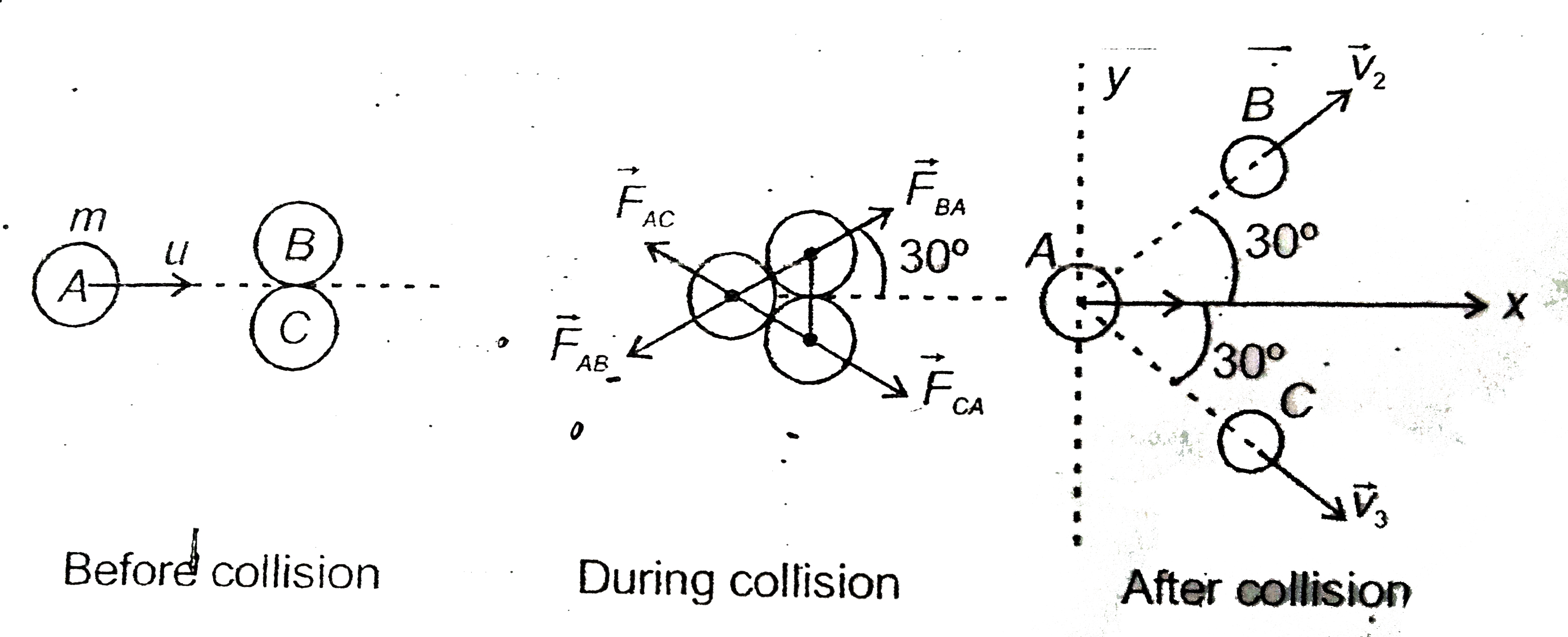B and C are two identicalsphereskeptincontact with eachother on a horizontalfrictionaless floor.Another identicalspherea A moving with velocity u along the common tangent to B and C strikes B and C simultaneously.

Find their velocties after collision if
(a) Collision is elastic
(b) Collision is inelastic with coefficient of restitution e.

By conservation oflinear momentumalongy-axis,
mv2sin30∘−mv3sin30∘=0
⇒v2=v3=vo(say) …(1)
By conservation of linear momentum along x-axis
mu=mv1+mv2cos30∘+mv3cos30∘
v=v1+2v0cos30∘
v=v1+√3v0 ...(2)
Coefficient of restitution,
e=vseparationvapproach
1=v0−v1cos30∘ucos30∘. (for elastic collision)
⇒√3u2=v0−v1√32
u=2v0√3−v1 ...(3)
Adding equation (1) and (2),
2u=√3v0+2v0√3=3v0+2v0√3
u=5v02√3⇒v0=2√3u5 ...(4)
Putting value of v0 in equation (3),
v1=2v0√3−u=2√3¯2√3u5−u
=4u5−u
=−u5 ...(5)
(b) For inelastic collision
Total momentum of the system is conserved. We obrtain the same equations as in part (a) ⇒Equation(1)v1=v3=v0
Equation (2)u=v1+√3v0
Coefficient of restitution.
e=v0−v1cos30∘ucos30∘
⇒eu√32=v0v1√32
⇒u=2v0e√3−v12 ...(6)
Dividing equation (2) by e,
ue=v1e+√3v0e
Equation (6): u=2v0e√3−v1e
Adding, u(1e+1)=1e[5v0√3]
⇒v0=√3u5(1+e) ...(7)
Putting value of v0 in equation (6),
v1=(2v0√3−eu)
=u5(2−3e) ...(8)
Topper's Solved these Questions
- WORK, ENERGY AND POWERBook:AAKASH INSTITUTE ENGLISHChapter:WORK, ENERGY AND POWERExercise:IILUSTRATION
Explore 2 Videos
- WORK, ENERGY AND POWERBook:AAKASH INSTITUTE ENGLISHChapter:WORK, ENERGY AND POWERExercise:TRY YOURSELF
Explore 95 Videos
- WAVESBook:AAKASH INSTITUTE ENGLISHChapter:WAVESExercise:ASSIGNMENT ( SECTION-D ( Assertion - Reason Type Questions ))
Explore 12 Videos
Similar Questions
An object of mass m moving with speed u collides one dimentionally with another identical object at rest. Find their velocities after collision, if coefficient of restitution of collision is e.
View SolutionAn object of mass m moving with speed u collides one dimentionally with another identical object at rest. Find their velocities after collision, if coefficient of restitution of collision is e.
View Solution
Knowledge Check
Two identical balls A and B moving with velocities + 0.5 m/s and −0.3.m/s respectively collide head-on elastically. The velocities of the ball A and B after collision will be respectively
A+0.5m/sand+0.3m/sB−0.3m/sand+0.5m/sC + 0.3 m//s and + 0.5 m//sD−0.5m/sand+0.3m/s
A body of mass a moving with a velocity b strikes a body of mass c and gets embedded into it. The velocity of the systems after collision is
View SolutionTwo particles of masses m and 2m moving in opposite directions collide elastically with velocity 2v and v, respectiely. Find their velocities after collision.

View SolutionTwo balls of masses m and 2m moving in opposite directions collide head on elastically with velocities v and 2v. Find their velocities after collision.
View SolutionTwo balls of masses m and 2m moving in opposite directions collide head on elastically with velocities v and 2v. Find their velocities after collision.
View SolutionTwo indentical balls A and B moving with velocities uA and uB In the same direction collide. Coefficient of restitution is e.
(a) Deduce expression for velocities of the balls after the collision.
(b) If collision is perfectly elastic, what do you observe?
View SolutionA particle of mass 2kg moving with a velocity 5ˆim/s collides head-on with another particle of mass 3kg moving with a velocity −2ˆim/s. After the collision the first particle has speed of 1.6m/s in negative x-direction, Find
(a) velocity of the centre of mass after the collision,
(b) velocity of the second particle after the collision.
(c) coefficient of restitution.
View SolutionA particle of mass 2kg moving with a velocity 5ˆim/s collides head-on with another particle of mass 3kg moving with a velocity −2ˆim/s. After the collision the first particle has speed of 1.6m/s in negative x-direction, Find
(a) velocity of the centre of mass after the collision,
(b) velocity of the second particle after the collision.
(c) coefficient of restitution.
View Solution

